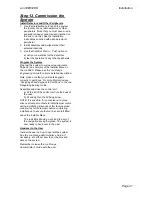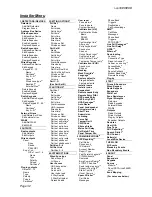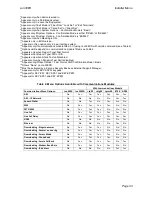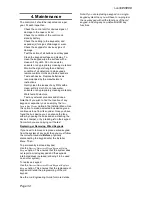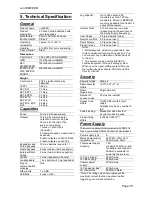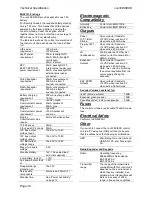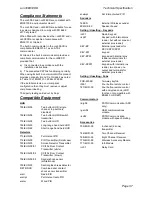
Installation
i-on30EX/EXD
Page 26
fail to re-fit the jumpers the internal communicator
will not connect to the phone line.
Step 9. Fit a Plug-By
Communicator
The control unit can be connected to a separate
communicator or speech dialler (for example, the
Scantronic 8400, 8440, 660 or RedCare STU).
Figure 47 shows the connections provided by the
communications wiring harness. Note that the
output types shown in Figure 47 are the Factory
default types. See the
i-on Range Engineering
Guide
for details on how to change the defaults.
Figure 47 Plug-By Communicator Wiring
Note: Comms O/P4 will be active when the
system is unset. This is normal.
To fit a communicator, follow the instructions
below.
Caution: Follow the instructions in the order
shown, or you may damage the
control unit and/or communicator.
1. Disconnect mains power from the control unit,
remove the case lid, and disconnect the
battery (if the system has already been
installed).
2. Make any necessary connections from the
communicator to the communication wiring
harness. The default is a 12V positive voltage
when the output is inactive.
Refer to the next section if you are using a
dual-path communicator.
3. Plug the Communication Wiring Harness onto
the communications connector on the main
PCB.
If the system has already been installed:
4. Re-connect the battery.
5. Fit the case lid.
6. Apply mains power.
7. Test communicator operation.
Note: You will need to speak to the ARC in order
to confirm that the communicator has worked
correctly.
Line Fail Input
This input is designed to allow a plug by
communicator to indicate to the control unit that
the communications link has failed. The
communicator should have an output capable of
ap12V to the Line Fail input while a line
fault is present and 0V when the fault is absent.
Tell Back Input
This input is designed to allow a plug by
communicator to indicate to the control unit that
the user can reset the system after a system
tamper. The communicator should have an output
that, when triggered remotely, can apply +12V for
at least 100ms
to the input. See “Remote Reset
(Redcare Reset)” in the i-on Engineering Guide
for more information.
Line Monitoring for a Dual-Path Communicator
If a standalone dual-path (landline and mobile)
communication device, such as a RedCARE STU,
is connected to the plug-by connector, you need
to do the following to obtain correct line fault
reporting that complies with BSIA Form No.175,
April 2005 (this is not necessary if you are using a
plug-on module):
1. Reprogram one of the plug by outputs to type
“ATS Test” and wire that output to the ATS
Test input of the communicator.
2. Wire the Line Fault output of the
communicator to the Line Fault input of the
plug-by connector. The communicator must
p12Vdc to indicate a line fault (for
example, if the Line Fault output at the
communicator uses a relay, connect the
common terminal of the relay to +12Vdc and
the normally-open terminal to the Line Fault
input of the plug-by connector).
The control unit will generate an "ATE L.F. Single"
alert if only one of the networks is not available, or
"ATE L.F. All" if both networks are not available.
Step 10. Fit and Connect
Battery
Fit a 7Ah Lead Acid battery into the battery
compartment in the bottom of the control unit (see
Figure 48).
Brown O/P1 (Fire)
Orange O/P 2 (Hold Up Alarm)
Yellow O/P 3 (Burglar Alarm)
Green O/P 4 (Open/Close)
Blue O/P 5 (Zone Omit (System))
Purple O/P 6 (Tamper)
White O/P 7 (Confirmed)
Grey O/P 8 (General Fault)
White/Brown Line Fault input
White/Orange Tell Back input
Black 0V
Red 12V
Brown O/P 9 (AC Fail)
Orange O/P 10 (Battery Fault)
Yellow O/P 11 (Technical Alarm)
Green O/P 12 (Alarm Abort)
Com Connector Cable,
Part number 485210
Con 7
Con 8
Com Connector Cable,
Part number 11960058
Содержание i-on30EX
Страница 1: ...i on30EX i on30EXD Security System Installation Guide Issue 6...
Страница 4: ...i on30EX EXD Page iv This page is intentionally blank...
Страница 42: ...i on30EX EXD Page 38 NOTES...
Страница 43: ...i on30EX EXD Page 39 NOTES...




















